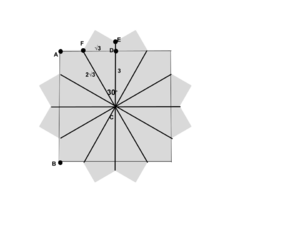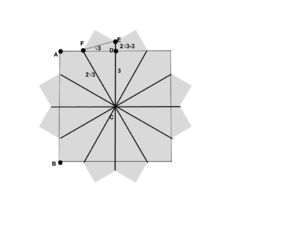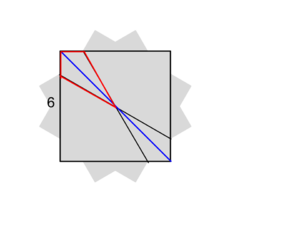Difference between revisions of "2021 Fall AMC 10B Problems/Problem 18"
Javawhiz12 (talk | contribs) (→Solution 4) |
Javawhiz12 (talk | contribs) (→Solution 4) |
||
| Line 170: | Line 170: | ||
[[Image:Longer Diagonal.png|thumb|center|2000|]] | [[Image:Longer Diagonal.png|thumb|center|2000|]] | ||
| − | We can find the longer diagonal of the kite by looking at one of the square sheets of paper. We know that the side of the square has a length of 6, so the diagonal of the square must be <math>6\sqrt{2}</math>. The longer diagonal is half of this length, so it has a length of <math>3\sqrt{2}</math>. | + | We can find the longer diagonal of the kite by looking at one of the square sheets of paper. We know that the side of the square has a length of 6, so the diagonal of the square must be <math>6\sqrt{2}</math>. The longer diagonal of the kite is half of this length, so it has a length of <math>3\sqrt{2}</math>. |
The area of the entire figure is | The area of the entire figure is | ||
Revision as of 23:18, 19 December 2021
Contents
Problem
Three identical square sheets of paper each with side length ![]() are stacked on top of each other. The middle sheet is rotated clockwise
are stacked on top of each other. The middle sheet is rotated clockwise ![]() about its center and the top sheet is rotated clockwise
about its center and the top sheet is rotated clockwise ![]() about its center, resulting in the
about its center, resulting in the ![]() -sided polygon shown in the figure below. The area of this polygon can be expressed in the form
-sided polygon shown in the figure below. The area of this polygon can be expressed in the form ![]() , where
, where ![]() ,
, ![]() , and
, and ![]() are positive integers, and
are positive integers, and ![]() is not divisible by the square of any prime. What is
is not divisible by the square of any prime. What is ![]()
![]()
![[asy] size(10cm,0); path p = box((0,0), (1,1)); draw(p, black + linewidth(2.0pt)); draw(rotate(30,(1/2,1/2))*p,black + linewidth(2.0pt)); draw(rotate(60,(1/2,1/2))*p,black + linewidth(2.0pt)); draw((0.2113248,1)--(0.7886752,1),white + linewidth(2.0pt)); draw((0.2113248,0)--(0.7886752,0),white + linewidth(2.0pt)); draw((1,0.2113248)--(1,0.7886752),white + linewidth(2.0pt)); draw((0,0.2113248)--(0,0.7886752),white + linewidth(2.0pt)); draw((0.5,1.07735026918)--(0,0.7886752),white + linewidth(2.0pt)); draw((0.5,1.07735026918)--(0,0.7886752),black+dashed+linewidth(2.0pt)); [/asy]](http://latex.artofproblemsolving.com/2/7/d/27dfd4852f123f02482ceb2f59ccad2c9543c7da.png)
Someone pls finish this
Solution 1
First note the useful fact that if ![]() is the circumradius of a dodecagon (
is the circumradius of a dodecagon (![]() -gon) the area of the figure is
-gon) the area of the figure is ![]() If we connect the vertices of the
If we connect the vertices of the ![]() squares we get a dodecagon. The radius of circumcircle of the dodecagon is simply half the diagonal of the square, which is
squares we get a dodecagon. The radius of circumcircle of the dodecagon is simply half the diagonal of the square, which is ![]() Thus the area of the dodecagon is
Thus the area of the dodecagon is ![]() But, the problem asks for the area of figure of rotated squares. This area is the area of the dodecagon, which was found, subtracting the
But, the problem asks for the area of figure of rotated squares. This area is the area of the dodecagon, which was found, subtracting the ![]() isosceles triangles, which are formed when connecting the vertices of the squares to created the dodecagon. To find this area, we need to know the base of the isosceles triangle, call this
isosceles triangles, which are formed when connecting the vertices of the squares to created the dodecagon. To find this area, we need to know the base of the isosceles triangle, call this ![]() Then, we can use Law of Cosines, on the triangle that is formed from the two vertices of the square and the center of the square. After computing, we get that
Then, we can use Law of Cosines, on the triangle that is formed from the two vertices of the square and the center of the square. After computing, we get that ![]() Realize that the
Realize that the ![]() isosceles are congruent with an angle measure of
isosceles are congruent with an angle measure of ![]() this means that we can create
this means that we can create ![]() congruent equilateral triangles with side length of
congruent equilateral triangles with side length of ![]() The area of the equilateral triangle is
The area of the equilateral triangle is ![]() Thus, the area of all the twelve small equilateral traingles are
Thus, the area of all the twelve small equilateral traingles are ![]() . Thus, the requested area is
. Thus, the requested area is ![]() Thus,
Thus, ![]() Thus, the answer is
Thus, the answer is ![]()
~NH14
Solution 2 (30-60-90 Triangles)
To make things simpler, let's take only the original sheet and the 30 degree rotated sheet. Then the diagram is this;
![[asy] size(10cm,0); path p = box((0,0), (1,1)); draw(p, black + linewidth(2.0pt)); draw(rotate(30,(1/2,1/2))*p,black + linewidth(2.0pt)); /*Rotate 60 degrees*/ [/asy]](http://latex.artofproblemsolving.com/1/d/1/1d18fa448a9d67e0133a366e5ace7d169451f836.png)
The area of this diagram is the original square plus the area of the four triangles that 'jut' out of the square. Because the square is rotated ![]() , each triangle is a 30-60-90 triangle. Similarly, the triangles that are bounded on the inside of the original square outside of the rotated square are also congruent 30-60-90 triangles. Noting this, we can do some labelling:
, each triangle is a 30-60-90 triangle. Similarly, the triangles that are bounded on the inside of the original square outside of the rotated square are also congruent 30-60-90 triangles. Noting this, we can do some labelling:
![[asy] size(10cm,0); path p = box((0,0), (1,1)); draw(p, black + linewidth(2.0pt)); draw(rotate(30,(1/2,1/2))*p,black + linewidth(2.0pt)); /*Rotate 60 degrees*/ label("$y$",(0.1,-0.05)); label("$x$",(0.4,0.05)); label("$y\sqrt{3}$",(0.8,-0.05)); label("$\frac{x}{2}$",(0.22,-0.12)); label("$\frac{x\sqrt{3}}{2}$",(0.5,-0.15)); label("$2y$",(0.8,0.15)); label("$y$",(1.05,0.1)); label("$\frac{x}{2}$",(1.12,0.22)); [/asy]](http://latex.artofproblemsolving.com/9/c/d/9cd2cf7a32b282cd81ea1059fb9218a0b425d1df.png)
Since the side lengths of the squares must be the same, and they are both 6, we have a system of equations;
![]()
![]()
We solve this to get ![]() and
and ![]() .
.
The area of each triangle is ![]() by plugging in
by plugging in ![]() .
.
The rotated 60 degree square is the same thing as rotating it 30 degrees counterclockwise, so it's triangles that jut out of the square will be congruent to the triangles we have found, and therefore they will have the same area.
Unfortunately, when drawing all three squares, we see the two triangles overlap; take the very top for example.
![[asy] import olympiad; size(10cm); pair A,B,C,D,E,F,G; A = (0.211,0); B=(0.3657,0); C = (0.63397,0); D = (0.789,0); E = (0.31666,0.1823); F=(0.5,0.077); G=(0.68334,0.1823); draw((0,0)--(1,0),black+linewidth(2pt)); draw(A--E--C--cycle); draw(B--D--G--cycle); label("$A$",A,S); label("$B$",B,S); label("$C$",C,S); label("$D$",D,S); label("$E$",E,N); label("$F$",F,N); label("$G$",G,N); [/asy]](http://latex.artofproblemsolving.com/f/1/6/f16ee002ef8b937fe059cd2d08ae91a2002615af.png)
The area of this shape is twice the area of each of the triangles that we have already found minus the area of the small triangle that is overlapped by the two by PIE. Now we only need to find the area of ![]() .
.
![]() and by symmetry
and by symmetry ![]() is isosceles, so it is a 30-30-120 triangle. If we draw a perpendicular, we split it into two 30-60-90 triangles;
is isosceles, so it is a 30-30-120 triangle. If we draw a perpendicular, we split it into two 30-60-90 triangles;
![[asy] import olympiad; size(10cm); pair A,B,C,D,E,F,G; A = (0.211,0); B=(0.3657,0); C = (0.63397,0); D = (0.789,0); E = (0.31666,0.1823); F=(0.5,0.077); G=(0.68334,0.1823); draw((0,0)--(1,0),black+linewidth(2pt)); draw(A--E--C--cycle); draw(B--D--G--cycle); draw(F--(0.5,0)); label("$A$",A,S); label("$B$",B,S); label("$C$",C,S); label("$D$",D,S); label("$E$",E,N); label("$F$",F,N); label("$G$",G,N); label("$H$",(0.5,0),S); [/asy]](http://latex.artofproblemsolving.com/0/c/2/0c25434b9a0f4f8f006dc23cc1f6dd3c27858cbf.png)
By symmetry, the distance from A to the edge of the square is equal to the distance from D to the edge of the square is equal to ![]() . AC = BD =
. AC = BD = ![]() , and the side length of the square is 6, so we use PIE to obtain
, and the side length of the square is 6, so we use PIE to obtain ![]() To find the height of
To find the height of ![]() , we see that
, we see that ![]() . Then by 30-60-90 triangles,
. Then by 30-60-90 triangles, ![]() . Finally, the area of
. Finally, the area of ![]() .
.
Putting it all together, the area of the entire diagram is the area of the square plus four of these triangle-triangle intersections. The area of these intersections by PIE is ![]() .
Therefore the total area is
.
Therefore the total area is ![]() .
.
Thus ![]()
~KingRavi
Solution 3
As shown in Image:2021_AMC_12B_(Nov)_Problem_15,_sol.png, all 12 vertices of three squares form a regular dodecagon (12-gon).
Denote by ![]() the center of this dodecagon.
the center of this dodecagon.
Hence, ![]() .
.
Because the length of a side of a square is 6, ![]() .
.
Hence, ![]() .
.
We notice that ![]() .
Hence,
.
Hence, ![]() .
.
Therefore, the area of the region that three squares cover is

Therefore, the answer is ![]() .
.
~Steven Chen (www.professorchenedu.com)
Solution 4
First, we can separate the shape into 12 congruent kites. The area of the figure can be determined by finding the area of one kite and multiplying it by 12. In order to to get the area of one kite, we need to find its diagonals, shown in blue.
We notice that angle FCE is ![]() . Also, we know that CD is half of AB, so it has a length of 3. Now, we can find the lengths of FC and FD using the 30-60-90 triangle. We find that FC is
. Also, we know that CD is half of AB, so it has a length of 3. Now, we can find the lengths of FC and FD using the 30-60-90 triangle. We find that FC is ![]() and FD is
and FD is ![]() . Since FC is congruent to CE, CE is also
. Since FC is congruent to CE, CE is also ![]() . Using this information, we can conclude that ED is
. Using this information, we can conclude that ED is ![]() .
.
Now, we can find the shorter diagonal by using the Pythagorean theorem:

We can find the longer diagonal of the kite by looking at one of the square sheets of paper. We know that the side of the square has a length of 6, so the diagonal of the square must be ![]() . The longer diagonal of the kite is half of this length, so it has a length of
. The longer diagonal of the kite is half of this length, so it has a length of ![]() .
.
The area of the entire figure is

Now we can use algebra to make our answer look a little nicer.

The area of the entire region is ![]() , or
, or ![]() .
.
Therefore, ![]() .
.
~JavaWhiz12
See Also
| 2021 Fall AMC 10B (Problems • Answer Key • Resources) | ||
| Preceded by Problem 17 |
Followed by Problem 19 | |
| 1 • 2 • 3 • 4 • 5 • 6 • 7 • 8 • 9 • 10 • 11 • 12 • 13 • 14 • 15 • 16 • 17 • 18 • 19 • 20 • 21 • 22 • 23 • 24 • 25 | ||
| All AMC 10 Problems and Solutions | ||
These problems are copyrighted © by the Mathematical Association of America, as part of the American Mathematics Competitions. ![]()













